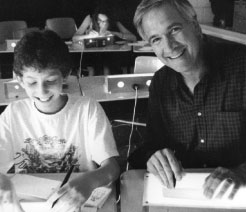Power of the Moving Line
 The animation of J.D. Pell Osborn '70 has illustrated national telecasts for ABC and PBS and appeared in festivals with the works of legends such as Chuck Jones (Bugs Bunny, Daffy Duck) and Bob Kurtz (The Pink Panther, Jurassic Park animation sequences). "I sometimes moved with the giants," Osborn said. But it has been his association with novices—students ages ten through sixty—that has defined his career.
The animation of J.D. Pell Osborn '70 has illustrated national telecasts for ABC and PBS and appeared in festivals with the works of legends such as Chuck Jones (Bugs Bunny, Daffy Duck) and Bob Kurtz (The Pink Panther, Jurassic Park animation sequences). "I sometimes moved with the giants," Osborn said. But it has been his association with novices—students ages ten through sixty—that has defined his career.
His passion for animation took a turn toward education when Osborn founded LineStorm, a program he runs in schools, colleges, and museums. A kind of a portable animation studio, LineStorm puts the tools of the trade (light boxes, pens, paper, reference images, and a laptop) in the hands of students, who sketch, storyboard, draft, and finally animate.
"With the right kind of materials, I help students follow the animation process used by animators at the original Disney and Warner Brothers studios," said Osborn. LineStorm has challenged the imaginations of clients ranging from sixth-graders in Boston's public schools to undergraduates at the Massachusetts Institute of Technology.
"The name LineStorm comes from 'brainstorming with a moving line,' but the actual animation we do is minor compared to the planning, pre-visualization, math, problem-solving, teamwork, and talking it requires," Osborn said. "Our projects teach discipline and teamwork, because animation is very time-consuming and we work in groups. High school principals have told me about shy underachievers who just blossomed personally and academically after participating in one of our projects. Some have gone on to become professional animators. It's very gratifying."
Animation is a powerful teaching tool because it taps into the earliest and most affectionate memories of the visual arts. As a kid, Osborn scoured TV Guide for animated Disney programs. He recalled seeing the 1944 Disney short, "How to be a Sailor"—a Goofy cartoon—and thinking it had the most beautiful movement he had ever seen. "Since then, I have always been interested in animation," he said.
He also traces his interest to his grandfather, an army general who was involved in the production of Frank Capra's "Why We Fight" series and other World War II propaganda films. "He would visit the Disney studios in Hollywood a couple of times each year and return with this amazing artwork," Osborn said.
LineStorm merges traditional and computerized animation, but emphasizes hand-drawn images encoded on a computer, to be colored, manipulated, and synchronized to sound. "The thirties and forties were a golden age of animation; the movement of art had never been better before and has scarcely been better since," Osborn said. "I am interested in the kind of animation that echoes the early hand-drawn Disney stuff."
A French major, Osborn credits Kenyon with fostering intellectual openness. The College "allowed me to explore different interests and try cool approaches to them," he said. "Kenyon opened so many doors for me. It never tied me down to one possibility or point of view."
After graduation, the Philadelphia native landed in Boston, where he worked for a film studio and took an animation class at Harvard. In 1982, he opened his MotionArt studio to do television broadcast and corporate work until enthusiastic responses to his occasional school seminars inspired him to launch LineStorm, which he also markets to corporate retreats for team-building exercises.
The venture reflects the broad-based learning approach and sense of self-discovery he borrowed from the liberal arts curriculum at Kenyon. "We don't tell kids to 'do this, do that.' We ask them to take an idea, draw it as a shape, and explore what it would say if it could talk and how it would move if it could move. We show them a path toward success in a totally different way," Osborn said.
A draft-deferred conscientious objector during the Vietnam War, Osborn asks his LineStorm students to explore issues of social justice, conflict resolution, and community service-values ingrained in him at Kenyon. "Even though I didn't do much animation there, Kenyon touched me with the notion to look around and explore. By the time I added up everything I learned there, it all counted."
—Dennis Fiely

 Delicious
Delicious Facebook
Facebook StumbleUpon
StumbleUpon Digg
Digg reddit
reddit